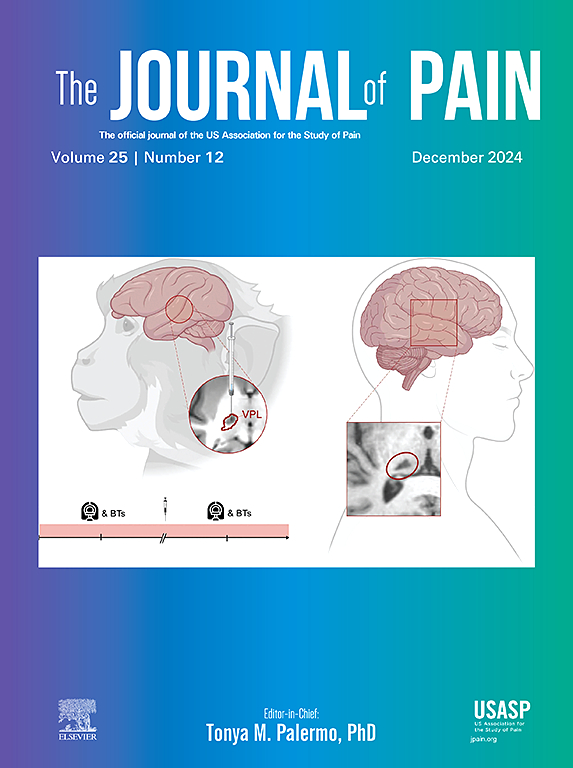黑人老年人的疼痛表型轨迹及其与家庭关系质量的关系
IF 4
2区 医学
Q1 CLINICAL NEUROLOGY
引用次数: 0
摘要
考虑到黑人老年人经历的持续疼痛差异,了解家庭关系和慢性疼痛如何在衰老过程中展开之间的联系具有重要的临床意义。本研究旨在确定不同的纵向疼痛表型轨迹,以及这些轨迹是否与老年美国黑人的家庭关系质量有关。我们纳入了黑人参与者(N=2586;64%的女性;平均年龄=66.65),来自全国代表性健康与退休研究的8个两年一期(2006-2020年),这些研究报告了基线时的疼痛发生率。疼痛发生率、严重程度、干扰和处方止痛药使用的潜在类分析(LCA)确定了三种横截面疼痛表型,一致地,在每个波:无疼痛;轻度至中度慢性疼痛;以及严重的慢性疼痛。二阶LCA同时确定了每个参与者在每个疼痛波中经历每种疼痛表型的概率,并确定了5种14年的疼痛表型轨迹:无慢性疼痛;持续性轻至中度慢性疼痛;持续性重度高冲击慢性疼痛;慢性疼痛康复;慢性疼痛恶化。与无痛的成年人相比,亲密伴侣支持程度越高,持续轻度至中度疼痛的几率越低,亲密伴侣压力越大,持续轻度至中度疼痛的几率越高。持续严重的高影响慢性疼痛的几率在亲密伴侣、家庭和亲子支持的情况下都较低,而在家庭和亲子关系紧张的情况下则较高。随着时间的推移,更大的亲子关系也与更高的疼痛恶化几率有关。改善紧张的关系和利用支持性关系的好处可能会提供一种与文化相协调的生物心理社会方法来改善老年美国黑人的痛苦。需要研究确定确定精确干预目标的中介机制。这篇文章描述了老年美国黑人疼痛表型的轨迹(不同疼痛指标的集群)。确定支持和紧张的家庭关系之间的联系,以及老年黑人成年人疼痛随着时间的推移展开的方式,可能为生物心理社会疼痛管理方法提供适当的干预目标。本文章由计算机程序翻译,如有差异,请以英文原文为准。
Pain phenotype trajectories and links to family relationship quality among black older adults
Given persistent pain disparities experienced by older Black adults, understanding associations between family relationships and how chronic pain unfolds during aging has important clinical implications. This study aims to identify distinct longitudinal pain phenotype trajectories and whether these are associated with family relationship quality among older Black Americans. We included Black participants (N=2586; 64% women; mean age=66.65) from eight biennial waves (2006–2020) of the nationally representative Health and Retirement Study who reported on pain incidence at baseline. Latent class analyses (LCA) of pain incidence, severity, interference, and prescription pain medication use identified three cross-sectional pain phenotypes, consistently, at each wave: no pain; mild-to-moderate chronic pain; and severe high-impact chronic pain. Second-order LCA determined each participant’s probability of experiencing each pain phenotype at each wave, simultaneously, and identified five 14-year pain phenotype trajectories: No Chronic Pain; Persistent Mild-to-Moderate Chronic Pain; Persistent Severe High-Impact Chronic Pain; Chronic Pain Recovery; Chronic Pain Worsening. Compared to pain-free adults, the odds of persistent mild-to-moderate pain were lower with greater intimate partner support and higher with greater intimate partner strain. The odds of persistent severe high-impact chronic pain were lower with greater intimate partner, family, and parent-child support, each, and higher with greater family and parent-child strain. Greater parent-child strain was also linked to higher odds of pain worsening over time. Ameliorating strained relationships and leveraging supportive relationship benefits may provide a culturally-attuned biopsychosocial approach to improving older Black Americans’ pain. Research is needed to determine mediating mechanisms for identification of precise intervention targets.
Perspective
This article describes trajectories of pain phenotypes (clusters of distinct pain indicators) for older Black Americans. Identified links between supportive and strained family relationships and ways in which aging Black adults’ pain unfolds over time may provide apt intervention targets in biopsychosocial pain management approaches.
求助全文
通过发布文献求助,成功后即可免费获取论文全文。
去求助
来源期刊

Journal of Pain
医学-临床神经学
CiteScore
6.30
自引率
7.50%
发文量
441
审稿时长
42 days
期刊介绍:
The Journal of Pain publishes original articles related to all aspects of pain, including clinical and basic research, patient care, education, and health policy. Articles selected for publication in the Journal are most commonly reports of original clinical research or reports of original basic research. In addition, invited critical reviews, including meta analyses of drugs for pain management, invited commentaries on reviews, and exceptional case studies are published in the Journal. The mission of the Journal is to improve the care of patients in pain by providing a forum for clinical researchers, basic scientists, clinicians, and other health professionals to publish original research.
 求助内容:
求助内容: 应助结果提醒方式:
应助结果提醒方式:


